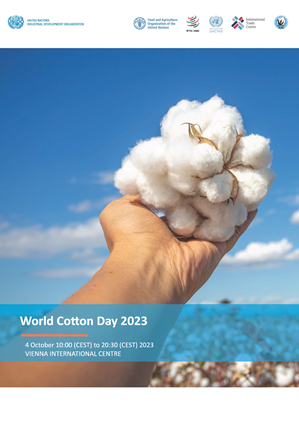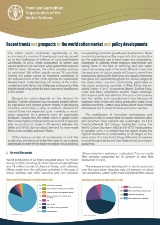Cotton, the fabric of our lives.
Cotton touches us every day, it is a source of livelihoods for millions of smallholders and labourers, including women and their families, and contributes significantly to the economies of many developing countries.
The World Cotton Day is an excellent opportunity to renew our commitment to enhancing the sustainability of the cotton sector and bring it to the forefront of the global agenda.
 4 October 2023, 9:00-18:00 hours (CEST)
4 October 2023, 9:00-18:00 hours (CEST)
Partners | Register
The World Cotton Day 2023 will take place on 4 October 2023 at the Vienna International Centre in Austria. It is jointly hosted by Secretariats of the United Nations Industrial Development Organization (UNIDO) and the Food and Agriculture Organization
of the United Nations (FAO) and is organized in cooperation with Secretariats of the World Trade Organization (WTO), the International Trade Center (ITC), the United Nations Conference on Trade and Development (UNCTAD) and the International Cotton
Advisory Committee (ICAC).
2023 Theme of World Cotton Day: “Making cotton fair and sustainable for all, from farm to fashion”.
Through WCD 2023, we aim to bring stakeholders together, raise visibility of the cotton sector and awareness of the critical role that it plays in economic transformation, agricultural and value chain development, international trade, and poverty alleviation. The observance also aims to highlight the importance of sustained economic growth, inclusive and sustainable industrial development, full and productive employment, and decent work for all.
World Cotton Day 2023 | UNIDO
Celebrating cotton
Cotton is a culture, a way of life, and a tradition with its roots at the heart of human civilization. In August 2021, the General Assembly of the United Nations recognised the unique benefits of cotton by proclaiming 7 October of each year as World Cotton Day. The objective of this global celebration is to raise the visibility of the cotton sector and awareness of the critical role that it plays in economic development, international trade and poverty alleviation.
Cotton is the most important of the natural fibres, used daily in apparel and home furnishings. Cotton is a critical means of livelihood for millions of smallholders and their families by providing employment and income. It represents an important source of export revenues for some of the poorest countries in the world. The World Cotton Day offers a unique opportunity to renew the commitment to a sustainable cotton sector for better production, better nutrition, a better environment, and a better life, leaving no one behind.Key messages
 | Cotton is an important means of livelihood for millions of smallholders, workers and their families, providing employment and income. |
 | Cotton exports represent an important source of foreign exchange earnings for a number of low-income countries, helping to cover their food import bills. |
 | Cotton faces a number of uncertainties on both the production and demand sides that need to be properly addressed if the sector is to realize its full potential in supporting economic growth and sustainable development. |
 | The cotton sector at all levels of the value chain represents a way to address wider development concerns to empower women and boost youth employment, while ensuring decent work for all. |
 | The mobilisation of innovative technologies and resources is vital to ensure that the sector remains viable and sustainable. |
 | Greater investments are needed to expand the sector beyond raw cotton production and create new income opportunities, especially for farmers, by adding more value to cotton fibre and developing by-products from other parts of the cotton plant. |
 | A rules-based, non-discriminatory, open, fair, inclusive, predictable and transparent international cotton trading system is key to provide a livelihood to hundreds of millions of vulnerable people around the globe. |
 | It is critical to reduce trade distorting domestic support measures for cotton and any other market distortions hampering the benefits from trade liberalization. |
Interesting facts about cotton
Did you know?
 | The top five cotton producing countries are China, India, the United States of America, Brazil and Pakistan, which together account for more than three-quarters of global production. |
 | It is estimated that about 32 million farmers produce cotton globally and nearly half of them are women. |
 | Around 80 percent of cotton is used in apparel, 15 percent in home furnishings and the remaining 5 percent mostly accounts for non-woven applications, such as filters and padding. |
Publications

OECD-FAO Agricultural Outlook 2023-2032 Chapter 10: Cotton
2023
This chapter describes market developments and medium-term projections for world cotton markets for the period 2023-32. Projections cover consumption, production, trade and prices developments for cotton. The chapter concludes with a discussion of key risks and uncertainties which could have implications for world cotton markets over the next decade.

OECD-FAO Agricultural Outlook 2023-2032
2023
The OECD-FAO Agricultural Outlook provides an assessment of the prospects of national, regional and global agricultural commodity markets over the coming decade. The baseline projections for production, consumption, stocks, trade and prices for cereals, oilseeds and oilseed products, roots & tubers, pulses, sugar, meat, dairy products, fish, cotton, biofuels and tropical fruits cover the years 2023 to 2032.

Gender dimension in the Cotton Sector: characterising the role of women
2023
Cotton is an important source of livelihood for millions of smallholders worldwide and women contribute significantly to cotton farming, constituting a large share of the workforce involved in primary production. However, women face disproportionate barriers along the cotton value chain in terms of access to land, inputs and services that affect the quality of their participation and the benefit they can derive.

The Cotton-4 (C-4) countries in the context of the global cotton market: Situation and short- and medium-term outlook
2022
This document analyses the cotton market in the Cotton-4 (C-4) countries, Benin, Burkina Faso, Chad and Mali. It studies the current market situation and medium-term prospects of the sector and considers the way forward.

Recent trends and prospects in the world cotton market and policy developments
2021
The cotton sector contributes significantly to the economies of a number of developing countries, as well as to the livelihoods of millions of rural smallholders worldwide. In 2019, world production of cotton was valued at about USD 46 billion, while global trade reached USD 15 billion.

Recent trends and prospects in the world cotton market and policy developments - Executive Summary
2021
The cotton sector contributes significantly to the economies of a number of developing countries, as well as to the livelihoods of millions of rural smallholders worldwide.
Multimedia
Cotton, weaving a better future
13/10/2022
From field to fabric, the familiar touch of cotton is woven into our lives. Cotton is one of the oldest natural fibers. It is the thread connecting civilizations.
Cotton, weaving a better future together (partners)
11/10/2022
More than just a textile, cotton is a culture and a way of life for hundreds of millions of households worldwide. Cotton creates jobs and incomes for millions at the heart of the supply chain.
Live Culture Native Cotton
15/09/2022
María Rosa Farroñán, Mochica indigenous cotton farmer and artisan shares her experience cultivating and spinning Peruvian native cotton fiber.
Single line cotton harvester
23/09/2022
Within the framework of the Trilateral + Cotton South-South Cooperation Project, implemented jointly by the Government of Brazil through the Brazilian Cooperation Agency (ABC / MRE), FAO and the project's partner countries, it has been developed with the support from Embrapa Algodón, a protot...
Ending child labour among cotton growing communities in Burkina Faso, Mali, Pakistan
22/04/2022
Cotton is one of the most common fabrics in the world. Its production is heavily dependent on natural resources and labour. Unfortunately, child labour is often a part of this. Child labour is work that is inappropriate for a child’s age, or harmful to children’s education, health, safety or ...
Related links
- FAO Markets and Trade
- Committee on Commodity Problems (CCP)
- FAO Intergovernmental Group (IGG) on Hard Fibres and the IGG on Jute, Kenaf and Allied Fibres
- Global Commodity Markets
- FAO Plant Production and Protection Division
- Commodity in focus: Cotton
Regional focus
- Program of Brazil-FAO International Cooperation
- Brazilian Cooperation Agency|Ministry of Foreign Affairs (ABC/MRE)
- Decent rural employment
- CLEAR Cotton project
- +Cotton Project videos
Partners
- United Nations Conference on Trade and Development (UNCTAD)
- World Trade Organization (WTO)
- International Trade Centre (ITC)
- International Cotton Advisory Committee (ICAC)
For general inquiries, contact:
Partners












